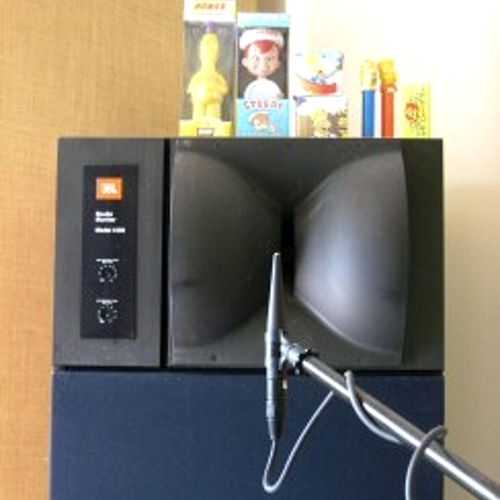
Here’s The Proof
To save you the bother of recording an entire session onto two recorders simultaneously at different levels, I tested this myself and the results confirm what I’ve said for years in audio forums.
It’s not practical for me to record an entire band in my home studio because that requires dozens of microphones and simultaneous input channels. So I did the next best thing: I played each track of an existing song one by one, and re-amped (re-recorded) them using a loudspeaker and microphone to two tracks at the same time with the levels 20 dB apart.
Whether re-amping a loudspeaker captures the same sound as a microphone on a singer or drum set is irrelevant. The source simply is what it is, and a loudspeaker source is as valid as any other to disprove the myth that sound quality changes depending on signal level.
I used the 8-track “master tape” files of the 1967 Motown hit Ain’t No Mountain High Enough that made the rounds a while ago.
The accompanying photo shows the test setup with my large JBL 4430 loudspeaker and a precision DPA 4090 microphone 18 inches in front of the center of the horn.
The output of the mic preamp went through a Y-splitter, then into both inputs of my Focusrite 8i6 sound card. I set the Focusrite’s preamp levels so one track peaked above -6 dBFS, with the other track 20 dB softer. Then I recorded at 16 bits instead of 24 to make this a worse-case test.
Since I already had a basic mix of this tune, I simply solo’d each playback track one by one while recording the new pairs of tracks. Both groups of the newly recorded tracks were sent to their own output bus with the volumes set to peak just below 0 dBFS, then rendered to separate “A” and “B” Wave files. I exported only 25 seconds of the tune to keep the file sizes reasonable (4.5 MB each), then put them on my web site below for readers to download and play:
Your mission is to identity which mix was made from the files recorded so they peak near 0 dBFS, and which mix came from the files that were recorded 20 dB softer. If you think you hear a difference, email me your choices from my Home Page and I’ll reply with the answer.
In all honesty, both mixes sound exactly the same to me, but maybe others have better (and younger) ears than mine. However, when I nulled the two mixdown files to assess their difference, the nulled residual was down around -50 dB. That file is also linked above to save you the bother of loading both mixes into a DAW to align and null them yourself. (Nulling is explained in the following part of the Audio Myths video.)
